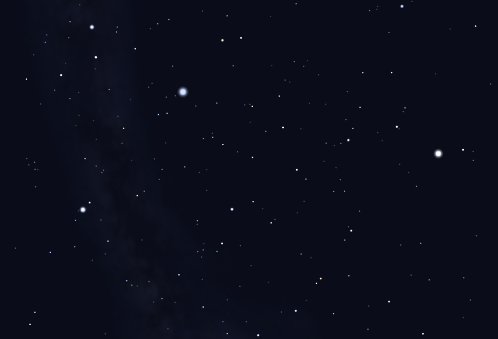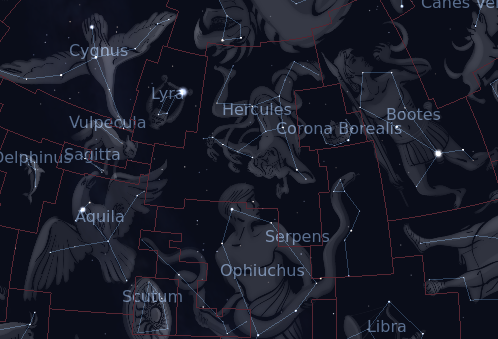The Constellation Hercules
Hercules is a large northern constellation, culminating at midnight in May. It has the fifth largest area of all the constellations.
Despite this, it covers a rather dark area of the sky and has only two stars brighter than third magnitude. It is best known for its deep sky offerings, which include M13, often known as the ‘Great Globular Cluster in Hercules’. M13 is the brightest globular cluster to lie at a high northern declination.
It is also home to another bright globular cluster, M92, as well as the much fainter cluster NGC 6229.
The name ‘Hercules’ is Latinised name for the Greek hero Heracles. The constellation is probably much older than any association with Hercules: in the third century BC, Aratus referred to the constellation as depicting a nameless man, but a century later, Eratosthenes identified him as Heracles.
The figure is usually drawn with his foot on the head of the dragon Draco, which is appropriate as one of the labors of Hercules was to slay the dragon which guarded the golden apples which grew in the garden of Hera.
Ancient
3.0% of the sky
1225.1 square degrees
Hercules contains no Caldwell objects
The following constellations neighbor Hercules: Aquila, Bootes, Corona Borealis, Draco, Lyra, Ophiuchus, Sagitta, Serpens Caput, Vulpecula.
Hover the pointer over the name of an object to highlight its position on the starchart to the right, or click to see more information.
| Stars | Open Clusters | Globular Clusters | Galaxies |
| Kornephoros (mag 2.8) | NGC 6659 | Messier 13 (mag 5.8) | NGC 6482 (mag 11.3) |
| ζ-Her (mag 2.9) | Messier 92 (mag 6.5) | NGC 6207 (mag 11.6) | |
| Sarin (mag 3.1) | NGC 6229 (mag 9.9) | NGC 6548 (mag 11.7) | |
| π-Her (mag 3.1) | NGC 6658 (mag 11.8) | ||
| Rasalgethi (mag 3.3) | NGC 6181 (mag 11.8) | ||
| μ-Her (mag 3.4) | NGC 6166 (mag 11.9) | ||
| η-Her (mag 3.5) | NGC 6574 (mag 12.0) | ||
| ξ-Her (mag 3.7) | NGC 6487 (mag 12.0) | ||
| γ-Her (mag 3.7) | NGC 6674 (mag 12.1) | ||
| ι-Her (mag 3.8) | NGC 6389 (mag 12.1) | ||
| O-Her (mag 3.8) | NGC 6587 (mag 12.1) | ||
| θ-Her (mag 3.8) | NGC 6173 (mag 12.1) | ||
| 109-Her (mag 3.9) | NGC 6632 (mag 12.2) | ||
| τ-Her (mag 3.9) | NGC 6106 (mag 12.2) | ||
| ε-Her (mag 3.9) | NGC 6501 (mag 12.3) | ||
| σ-Her (mag 4.2) | NGC 6269 (mag 12.3) | ||
| 110-Her (mag 4.2) | NGC 6660 (mag 12.4) | ||
| φ-Her (mag 4.2) | NGC 6555 (mag 12.4) | ||
| 102-Her (mag 4.3) | NGC 6239 (mag 12.4) | ||
| 111-Her (mag 4.3) | NGC 6146 (mag 12.5) | ||
| Maasym (mag 4.4) | NGC 6500 (mag 12.5) | ||
| ν-Her (mag 4.4) | NGC 6577 (mag 12.7) | ||
| HIP 85112 (mag 4.5) | NGC 6599 (mag 12.8) | ||
| ρ-Her (mag 4.5) | IC 1269 (mag 12.8) | ||
| ω-Her (mag 4.6) | NGC 6255 (mag 12.9) | ||
| 113-Her (mag 4.6) | NGC 6379 (mag 12.9) | ||
| χ-Her (mag 4.6) | NGC 6196 (mag 12.9) | ||
| e-Her (mag 4.6) | NGC 6372 (mag 12.9) | ||
| 93-Her (mag 4.7) | NGC 6030 (mag 12.9) | ||
| υ-Her (mag 4.7) | NGC 6447 (mag 13.0) |




